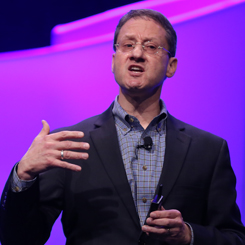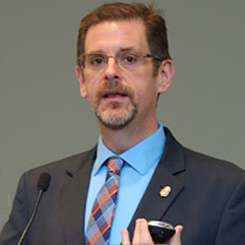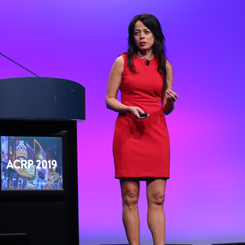Technology talk dominated the hallways and session rooms at the recent ACRP 2019 gathering in Nashville, Tenn. earlier this month (View Highlights). More than 40% of attendees of the opening plenary session who answered a polling question said “adopting digital innovation” was the biggest area of opportunity for clinical research. Another 23% chose “leveraging real-world data,” while 21% selected “greater patient involvement.”
Nearly 15% cited “implementing new trial designs” as their top choice. Interestingly, just 2% chose “other,” suggesting the choices offered in the poll hit the hottest topics among attendees.
In workshops, sessions, networking events, and elsewhere, attendees heard other common refrains, including the irrefutable fact that the clinical trial industry is going through a sea change with no end in sight. Here’s a closer look at a few of the top themes that surfaced at ACRP 2019.
Big Changes are Here – And There’s More to Come
“Half of what you know will be obsolete in 18 months,” WCG Executive Chairman and Chief Executive Officer Donald Deieso told an opening day audience at ACRP 2019. Successful practitioners, he said, will be “excited” by the challenge and welcome it. “Embrace your next level of contribution,” he said.

Driven by new technologies, an avalanche of patient data, and new economic pressures, among several other factors, the clinical trial of the future is liable to be more “flexible, adaptative, pragmatic,” and collaborative in design, industry thought-leader Ken Getz told a packed auditorium. “All of this will require a culture change, a different way of thinking.”
Trends coming down the pike speak “to the huge need to demonstrate that the professionals supporting this enterprise have the competency and training in whatever environment we operate to support the factors that would support compliance and integrity” in clinical trial conduct, Getz noted.
Applauding the “sacred” work done by those in the audience, CEO and Founder of InitiativeOne Dr. Fred Johnson challenged attendees to do even better. “You didn’t decide to play in the minor leagues,” he said. “You are using your gifts to make an impact in your field to help shape the cures and clinical trials being developed to make a difference in people’s lives long after you are gone,” he added.
“Change is hard” is a common sentiment heard during new projects, Forte Systems Inc. Senior Vice President for Services Ora Mester cautioned, but the day can be won through communicating clearly, adjusting your messaging based on your audience, planning ahead to address predictable concerns, and executing on your communication plan early.
The Workforce Needs Standards, Competencies, and New Ways of Training
Genentech Global Head for Product Development Industry Collaborations Virginia Nido advocated the power of ongoing learning and curiosity. “Make sure you have foundational training,” said Nido, who is also a member of the Association Board of Trustees for ACRP and a newly minted holder of an ACRP Certified Professional (ACRP-CP) credential. “Then go for it and dig into that change. Thank you for all of your hard work; and if I were a patient in a clinical trial, I would want to see you,” she told the audience.
Other speakers and leaders voiced support for further professionalizing the clinical trial workforce via standards and competencies.
In the early decades of the 20th century, there was something of a wild west mentality with a relatively unregulated airline industry, but it wasn’t long before it became obvious that people entrusted with such important and challenging work should be required to demonstrate certain competencies and meet certain standards, said ACRP Executive Director Jim Kremidas
“By contrast, I maintain the clinical research industry hasn’t received some of the respect and attention it deserves,” Kremidas told attendees. “We know what needs to be done—grow a competent clinical research workforce, define the competencies required and align the industry, and validate the competencies.”

Those waiting to get marching order from the very top heard from Eric Pittman, Program Division Director with the Office of Bioresearch Monitoring Operations in the Office of Regulatory Affairs at the U.S. Food and Drug Administration (FDA). More than half of attendee at his session said they felt “very” or “pretty well” prepared before they got word the FDA was planning an inspection. The bad news? Nearly a quarter of respondents chose the “Who is FDA?” option.
It bears repeating, Pittman said, that it is critical to “provide training to staff on regulatory requirements, specific protocol requirements, any processes or procedures,” and otherwise “facilitate open communications” with the agency. Further, everyone has to understand “not just the what, but the why compliance matters,” he added.
Meanwhile, training is key to many uses of new technology, such as electronic regulatory binders, according to Melissa Bolton, MBA, CCRC, a Clinical Project Manager with the University of Utah. “If research staff are new or inexperienced, they likely won’t be aware of everything that should be in a regulatory binder,” she warned.
Technology is Great, But Make Sure it Works for You and Not the Other Way Around
Taking a closer look at technology, speakers and attendees shared a number of interesting insights. “Focus on user training and continued training,” said Susan Donahue, Director of Clinical Operations at Javara. “I think that’s the key.”
“We as an industry are notoriously bad at consuming advances in technology; we don’t do them in a way that perhaps other industries [including banking and aviation] do,” said Dalvir Gill, PhD, CEO of TransCelerate BioPharma, Inc., at a panel session. “Some of it is reluctance, but we’re also hampered by the fact that there are laws that we’ve created [that] create barriers that we have to systematically chip away.”
“You have to look at some of the new technology as an opportunity,” added Jamie Macdonald, CEO of PAREXEL International, at the same session. While championing many flavors of technology and the value of hybrid virtual trials, Macdonald was quick to add that “sites are still pivotal. I think what we’re seeing is data doesn’t enroll clinical trials.”
In other words, data may tell us where patients are physically, but “it’s a very human process to engage with a physician, to discuss clinical trials as an option for their care, to consider consenting and screening, and then staying involved with the clinical trial,” Macdonald said.
According to the 2018 Veeva Unified Clinical Survey, 83% of respondents say their companies are taking action to streamline study start-up, Veeva Systems Director of Vault Study Startup Ashley Davidson noted, but she added that the solutions can’t all be about the technology being used. In part, this is because study start-up “doesn’t happen in a bubble,” she explained—it touches on many parts of the ongoing study, as well.
“I actually don’t think technology is what’s going to solve” the study-start up dilemma, Davidson said. She believes technology needs to come together with people and processes in a risk-based approach that increases transparency and collaboration across the study team, takes a holistic view of study start-up as an end-to-end process, and allows researchers to measure and optimize start-up processes.

“Technology is coming, and we all need to embrace it,” said Nido. For example, a new generation of wearables is also creating “new job accountability” for clinical trial professionals, she noted. Studies have shown that when there is a problem with a device, users want to go to their clinical trial contact for answers, not the product manufacturer. “There’s so much more for us to learn today,” Nido said.
Hype and headlines notwithstanding, don’t count on so-called virtual trials replacing all humans anytime soon, though. While they will definitely have their uses, virtual trials are very limited when patients are actually sick, said Andy Lee, Senior Vice President and Head of Global Clinical Trial Operations at Merck. “There’s no do-it-at-home kit for biopsies,” he noted. Instead, the technology should free clinical research associate professionals up to use their time more efficiently. “You are one of the most critical components of clinical trials,” Lee told the ACRP audience.
Never Forget: It’s All About Patients
Finally, inspiring speaker Kristen Smedley brought the impact of clinical trials close to home with a powerful narrative about her two sons born with a rare type of blindness that takes hold years after birth.

Smedley reminded the ACRP audience to think carefully when setting up endpoints in clinical trials. It’s easy to let assumptions become unintended obstacles to better patient treatments. For example, while many sighted people would assume being able to read the letters on a standard eye chart with lists of letters and numbers is a good indicator of vision acuity, Smedley pointed out that for patients actually suffering from or facing a form of blindness, their individual indicators are quite different (e.g., how well they can see at dusk versus the middle of a bright, sunny day).
“The challenge with blindness is independence and mobility, or lack thereof,” Smedley said. The patient community said, “’forget about the eye chart, we need independence and mobility and the rest will be good to go,’” she added. “Think in terms of meaningful endpoints and outcomes that make sense for the patient you are working for,” she advised. Even as she made the point, though, she stressed that “we’ve come a long way in communications with the patient community.”
Authors: Michael Causey and Gary Cramer



